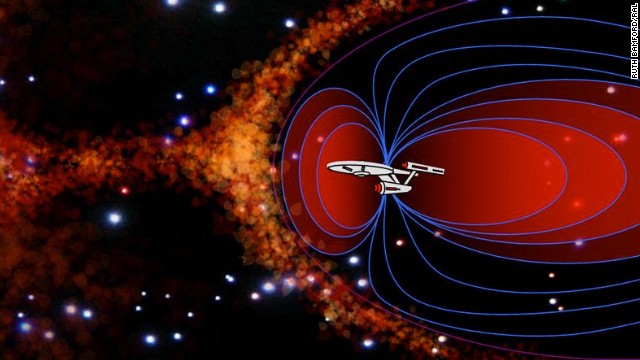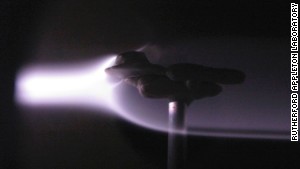July 2, 2013 -- Updated 1639 GMT (0039 HKT)

The deflector shield is aimed at protecting spaceship occupants from harmful radiation given off by the Sun.
STORY HIGHLIGHTS
- NASA's Curiosity mission to Mars revealed that astronauts on a round-trip would face high radiation levels
- Scientists at the UK's Rutherford Appleton Laboratory are working on a radiation shield for astronauts
- A model has been tested inside a fusion reactor which produces a plasma like that of the solar wind
- The team are hoping to test their concept in space in the next five years
But wait. Recent evidence
from NASA's Curiosity rover mission to the Red Planet has revealed that
astronauts on the round-trip would be exposed to high levels of radiation
from cosmic rays and high-energy particles from the sun contained in
solar storms. NASA says a Mars voyager would receive a radiation dose
around 100 times the average yearly exposure on Earth.
Along with all the other
risks of spaceflight, this would clearly be bad for your health -- and
it is proving difficult to find a solution.
Eddie Semones, a
radiation health expert at NASA's Johnson Space Flight Center, told CNN
that shielding to completely block the radiation danger would have to be
"meters thick" and too heavy to be used aboard a spacecraft.

A model with the mini-magnetosphere shield is tested in a plasma stream.
In contrast, with the
release of the Star Trek movie "Into Darkness," science fiction fans
have once again got used to the ease with which Captain Kirk gives the
order for "shields up" and the crew of the Enterprise being protected
instantly from the hostility of space.
Perhaps though, a real
Star Trek shield may no longer be science fiction -- scientists at the
UK's Rutherford Appleton Laboratory (RAL) certainly think so.
Radiation 'potential showstopper'
They have been testing a
lightweight system to protect astronauts and spacecraft components from
harmful radiation and working with colleagues in America to design a
concept spaceship called Discovery that could take astronauts to the
Moon or Mars.
"Star Trek has great
ideas -- they just don't have to build it," said Ruth Bamford, lead
researcher for the deflector shield project at RAL.
"The radiation problem
is a potential showstopper. I'm very concerned that the radiation issue
is not being addressed very publicly and it's absolutely key.
"Even if astronauts are
sick for 3-4 days, it could still threaten the mission because the whole
crew are affected -- and vomiting and diarrhea in space is no joke. It
could also potentially lead to organ failure," said Bamford.
The RAL plan is to
create an environment around the spacecraft that mimics the Earth's
magnetic field and recreates the protection we enjoy on the ground --
they call it a mini magnetosphere.
Even if astronauts are sick for 3-4 days, it could still threaten
the mission because the whole crew are affected -- and vomiting and
diarrhea in space is no joke.
Space scientist, Ruth Bamford
Space scientist, Ruth Bamford
"On Earth, mostly we're
protected by the atmosphere but ultimately what the Earth's magnetic
field is doing is forming a first line of protection for life,"
explained Bamford.
"The concept behind what
we're suggesting is due to the evolution in our understanding of
plasmas. What we discovered is that if you put a magnetic field around
an object in a flowing plasma, the electrons, which are very light, will
follow the new magnetic field that you've put there but the ions, the
very fast ions, will overshoot -- they won't follow the magnetic field
lines.
"You end up with a
constant electric field that can be enough that it actually refracts or
deflects enough of the radiation from inside the magnetic cavity that
you've formed to protect the astronauts ... enough like the Earth that
they can survive."
The mini-magnetosphere
concept has also been proposed by a team at the University of Washington
in the United States as a way of harnessing the solar wind to create a propulsion system.
Other shielding ideas are also being explored. The Inspiration Mars Foundation
that is committed to sending a crew to Mars has proposed lining the
spacecraft's walls with water, food and even human waste to help protect
the astronauts.
Early results 'pleasing'
New Scientist magazine
recently reported that the "hydrocarbons in excrement and food are good
candidates for radiation shielding."
It added: "NASA's Water Walls project uses a similar concept, but Inspiration must make it work for real."
As a child, Bamford was
inspired to explore a scientific career by the Apollo moon landings and
is a fan of the Star Trek series. She believes the concepts explored in
the science fiction films are a useful shorthand for scientists when
trying to explain their work.
The RAL deflector shield
she has helped to develop has been tested on a model inside a fusion
reactor which produces a plasma like that of the solar wind. Bamford
said they were delighted with the results.
The RAL team now hope
the project can be scaled up and fly on a real craft. "First we need a
technology demonstrator in space in, say, five years," said Bamford.
"That's quite realistic for a dedicated, small, unmanned spacecraft.
"I'm sure our idea will
work. It does work. There are a number of improvements to make it work
better though -- perhaps we should call down to Scotty."
No comments:
Post a Comment